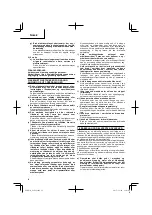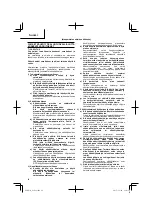
30
English
Switch OFF: To release the locking mode, press the
switch lever in the direction of B shown in
Fig. 3-a
, and release the switch lever to
switch o
ff
.
[When the switch has no locking mechanism]
To switch on, slide the o
ff
lock lever in the direction of A
and press the switch lever in the direction of B as shown
in
Fig. 3-a
.
Release the switch lever to switch o
ff
.
5. Precautions immediately after
fi
nishing operation
The wheel continues to rotate after the tool is switched
o
ff
.
After switching o
ff
the machine, do not put it down until
the depressed center wheel has come to a complete
stop. Apart from avoiding serious accidents, this
precaution will reduce the amount of dust and swarf
sucked into the machine.
CAUTION
○
Check that the work piece is properly supported.
○
Ensure that ventilation openings are kept clear when
working in dusty conditions.
If it should become necessary to clear dust,
fi
rst
disconnect the tool from the mains supply (use non-
metallic objects) and avoid damaging internal parts.
○
Ensure that sparks resulting from use do not create
a hazard e.g. do not hit persons, or ignite
fl
ammable
substances.
○
Always use eye and ear protection.
Other personal protective equipment such as dust
mask, gloves, helmet and apron should be worn when
necessary.
If in doubt, wear the protective equipment.
○
When the machine is not use, the power source should
be disconnected.
ASSEMBLING AND DISASSEMBLING THE
DEPRESSED CENTER WHEEL (Fig. 2)
CAUTION
Be sure to switch OFF and disconnect the
attachment plug from the receptacle to avoid a
serious accident.
1. Assembling (Fig. 2)
(1) Turn the disc grinder upsidedown so that the spindle is
facing upward.
(2) Align the across
fl
ats of the wheel washer with the
notched part of the spindle, then attach them.
(3) Fit the protuberance of the depressed center wheel
onto the wheel washer.
(4) Screw the wheel nut onto the spindle.
(5) While pushing the push button with one hand, lock the
spindle by turning the depressed center wheel slowly
with the other hand.
Tighten the wheel nut by using the supplied wrench as
shown in
Fig. 2
.
2. Disassembling
Follow the above procedures in reverse.
CAUTION
○
Con
fi
rm that the depressed center wheel is mounted
fi
rmly.
○
Con
fi
rm that the push button is disengaged by pushing
push button two or three times before switching the
power tool on.
MAINTENANCE AND INSPECTION
1. Inspecting the depressed center wheel
Ensure that the depressed center wheel is free of
cracks and surface defects.
2. Inspecting the mounting screws
Regularly inspect all mounting screws and ensure that
they are properly tightened. Should any of the screws
be loose, retighten them immediately. Failure to do so
could result in serious hazard.
3. Inspecting the carbon brushes
For your continued safety and electrical shock
protection, carbon brush inspection and replacement
on this tool should ONLY be performed by a HiKOKI
AUTHORIZED SERVICE CENTER.
4. Replacing supply cord
If the supply cord of Tool is damaged, the Tool must be
returned to HiKOKI Authorized Service Center for the
cord to be replaced.
5. Maintenance of the motor
The motor unit winding is the very “heart” of the power
tool. Exercise due care to ensure the winding does not
become damaged and/or wet with oil or water.
6. Service parts list
CAUTION
Repair,
modi
fi
cation and inspection of HiKOKI Power
Tools must be carried out by a HiKOKI Authorized
Service Center.
This Parts List will be helpful if presented with the tool to
the HiKOKI Authorized Service Center when requesting
repair or other maintenance.
In the operation and maintenance of power tools, the
safety regulations and standards prescribed in each
country must be observed.
MODIFICATIONS
HiKOKI Power Tools are constantly being improved
and modi
fi
ed to incorporate the latest technological
advancements.
Accordingly, some parts may be changed without prior
notice.
NOTE
Due to HiKOKI’s continuing program of research and
development, the speci
fi
cations herein are subject to
change without prior notice.
Information concerning airborne noise and vibration
The measured values were determined according to
EN60745 and declared in accordance with ISO 4871.
Measured A-weighted sound power level: 97 dB (A).
Measured A-weighted sound pressure level: 86 dB (A).
Uncertainty K: 3 dB (A).
Wear ear protection.
Vibration total values (triax vector sum) determined
according to EN60745.
Surface grinding:
Vibration emission value
a
h, AG
= 9.0 m/s
2
Uncertainty K = 1.5 m/s
2
000Book̲G10SQ.indb 30
000Book̲G10SQ.indb 30
2017/12/04 12:03:52
2017/12/04 12:03:52







































